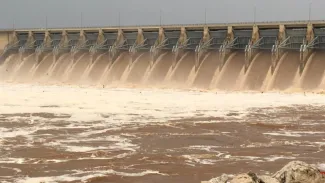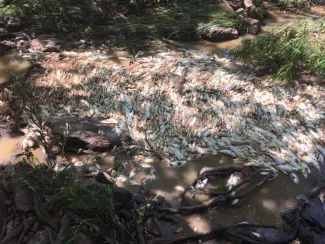Oklahoma residents survived another "100 year" flooding event this past summer. Heavy property damage and loss occurred in most of northeast Oklahoma. The last rain event of this size took place in 1996 which devastated the eastern side of our state. At the height of the event, the U.S. Army Corps of Engineer was releasing 275,000 cubic feet per second at Keystone Dam. That’s enough water to fill the University of Oklahoma’s Memorial Football Stadium once every 75 seconds. Impoundments situated along the Arkansas River could only do so much to hold back the torrential amounts of water. However, without them, there would have been much more devastation.

Keystone Dam near Sand Springs - May 23, 2019 (KFOR)
The Bad Things: Flooding Reservoirs and Rivers
Enormous changes to the terrain occurred including the removal of entire sections of river banks along with creek channels being moved or totally filled in. Major amounts of shoreline sloughing and undercutting also took place. Many tons of sand and sediment were moved with ease by the strong currents. Jetties and levees were compromised with ease resulting in flooded neighborhoods and farm land. The McClellan - Kerr Navigation System near Muskogee was closed to barge traffic. Major dredging operations will need to take place in order to return things to normal.
There is no way to know the exact number of fish that were washed downstream as a result of emergency releases from all the dams along the Arkansas River. Pelagic species such as shad, herring, white bass, striped bass and crappie were the most susceptible to high releases washing them over and through the taintor gates. Previous studies investigating fish movement in Oklahoma has shown striped bass specimens ending up in New Orleans after similar floods. Luckily most of the larger fish can avoid the currents and stay in the reservoir. Small or juvenile fishes are not so lucky.
Another issue that could potentially occur is the spread of non-native organisms from one water body to another. Plants, insects, fish, mollusks, etc. could all be redistributed after high flows. The white perch is one example of a fish that never existed in Oklahoma until Cheney and Wilson Reservoirs flooded around 2000. Today we find them in several waters connected to the Arkansas River. The zebra mussel is another organism that may have expanded it range due to this year’s flood. Future ODWC sampling outings will determine to what extent this took place.
The Bad Things: Flooding Lakes and Ponds
Damage on a smaller scale occurred in towns and parks away from the mainstem river. Dams and spillways were overwhelmed with the enormous quantities of water and simply gave way. For example, once the waters receded at Cushing Lake, approximately ½ million fish were found stranded in Big Creek below the dam. Additional events took place at Lake Carl Blackwell and Wister Reservoir. Low dissolved oxygen plus high water temperatures caused many fish kills once they were washed down stream.

Fish kill after Cushing Lake dam breach due to flood. (Ashley Nealis/ODWC)
On the Good Side of Things
Ponds and lakes were filled to their brims. In many cases, this was a needed occurrence in order to flush out old debris and accumulated sediment. Entire systems were re-charged. Nutrients were mixed into the water column which rejuvenated the food chain. As a result, excellent reproduction and recruitment should take place. River bottoms were scoured out creating new habitat for bottom dwelling organisms such as fish, crustacea and invertebrates. New habitat was added to pond and lakes such as submerged vegetation for fish nursery areas, trees, gravel and creek channels.
Overall floods cause changes for the betterment of the environment. Aquatic communities do recover by becoming more balanced, abundant and productive. Flood events have happened for millennia shaping the topography and regions we live in today. These will continue to go on and man can only learn to control / cope with them the best he can. Mother Nature, global warming or just bad luck we are all just part of a bigger picture and human habitation is at the mercy of it all.